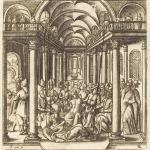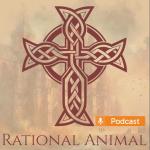In a speech to the meeting of the United States Conference of Catholic Bishops in Atlanta today, Catholic University of America president John Garvey plugged the upcoming Fortnight for Freedom by suggesting that: “Saving religious liberty means reminding people that they should love God.” We need to recover a sense of religion as a good. And we need to remind people that Christianity is a call to live as Christians, to be who we say we are. It’s not clinging to nostalgia but living differently. And the freedom to live that way is why we have the First Amendment, as Garvey said today.
He said:
Our society won’t care about religious freedom if it doesn’t care about God. That’s where reform is needed. We won’t have – and we probably won’t need – religious exemptions for nurses, doctors, teachers, social workers if no one is practicing their religion. The best way to protect religious freedom might be to remind people that they should love God.
Garvey laid out the religious-liberty threats domestically and challenged every one of us. His text, courtesy of CUA, my alma mater, is below:
Religious Freedom and the Love of God
Next week we begin the celebration of a Fortnight for Freedom. It starts on June 21, the vigil of the feast of St. Thomas More (and St. John Fisher). I want to say two things about More’s death. I will come back to them at the end. The connection between them is the point of my remarks.
First, More died because he loved God. Henry VIII split from the Catholic Church and had Parliament pass the Act of Supremacy (making him head of the Church of England) and the Act of Succession (making Anne Boleyn the queen). More refused to subscribe to the Acts. He tried to avoid a confrontation by resigning as Lord Chancellor, but Henry pursued him. And love for God and respect for the authority of the church compelled him to refuse the oath when it was forced on him. He died saying he was “the king’s good servant, but God’s first.”Second, religious liberty is important. More’s death was noble – he became a saint. It’s admirable to die for your religion if there is no alternative. But it would be a better world if we didn’t make people take that course. We protect the freedom of religion because we think it is wrong to coerce belief. Thomas More’s story shows what can happen when these protections break down.
Decline in Respect for Religious Freedom
We are not the kind of violent and intolerant society Tudor England was. But in recent years the landscape of religious freedom has changed. Its purview has narrowed considerably. Let me give six examples.1. EEOC – The Ministerial Exemption
Five months ago the Supreme Court decided an important case, Hosanna-Tabor Church v. EEOC. Certain employment discrimination laws (race, sex, age, handicap, etc.) authorize employees who have been wrongfully terminated to sue for reinstatement and damages. The question in Hosanna-Tabor was whether a minister could sue a church under one of these laws. The plantiff (Cheryl Perich) was a religion teacher in an Evangelical Lutheran grade school who claimed she had been the victim of handicap discrimination. Teachers like Perich perform pastoral functions. They must receive a ‘call’ from the congregation. They are commissioned in a public rite.
I am happy to say that the Supreme Court held for the church. It’s hard to imagine the government telling Lutherans whom they can hire as pastors. (Could the EEOC order the Catholic Church to ordain women?) As the Court saw it, called teachers are not very different. This unanimous decision was a big win in the judicial branch.The disappointing thing is that the executive branch took such a dim view of the church’s right. We might expect that the EEOC would side with the employee. But the Solicitor General of the United States argued that churches had no more rights in cases like this than would a labor union or a social club. The Supreme Court took the unusual step of calling this view “remarkable.”
2. NLRB – Collective Bargaining Exemption
The Labor Board has made its own efforts to exercise authority over religious teachers. In two recent cases NLRB Regional Directors have held that Manhattan College in New York and St. Xavier University in Chicago are not Catholic schools for purposes of exemption from the Wagner Act. The Board therefore allowed the adjunct faculty at each school to hold an election about forming a union. The schools have appealed to the full Board.The Supreme Court has held that the Wagner Act does not apply to lay teachers in Catholic high schools (shades of Hosanna-Tabor), because it’s their job to instruct students in the faith. Congress would not want the Labor Board to review their work. Should we have a different rule for colleges? The Board thinks we should, and its view is very much like the EEOC’s. The Board maintains that Catholic teachers are exempt only if they engage in “indoctrination” and “proselytizing.” College teachers and students live in an environment of academic freedom. Students don’t have to attend mass. Schools may hire non-Catholic faculty. Boards of trustees are dominated by lay people, not clergy and members of religious orders. This openness means (to the NLRB) that they should be subject to regulation.
This enthusiasm for regulating labor relations at Catholic colleges may just be an application of the policy of supporting unions, which the administration has shown in other sectors. But it shows a disappointing ignorance of, or disregard for, the way faith is communicated among intelligent adults. Faith is not an unthinking adherence that we come to only if we are forced, or swept along by a wave of mindless enthusiasm. Nor are the things we believe formulae we commit to memory, as fourth graders learn the catechism or ninth graders the axioms of geometry. Catholic universities bring their students and faculty to a better knowledge and love of God by appeals to the intellect and examples of virtue. These can’t be persuasive unless they occur in an atmosphere of academic freedom. The government should not make a rule that exempts only those colleges that conform to its (fairly ill-informed) view of how religion should be taught. Better to leave that to the Church.
3. HHS – Mandated Services
The Department of Health and Human Services has lately taken on religious institutions as well – not just colleges and universities, but also lower schools, hospitals, social service organizations like Catholic Charities, and so on. On January 20 it announced a final rule ordering group health plans to provide, at no added cost to subscribers, surgical sterilizations and all FDA approved contraceptives (including those that may induce abortions early in pregnancy). This means, for instance, that The Catholic University of America must offer these services to undergraduates who subscribe to its health plan, even though we view sterilization, contraception, and abortion as moral evils.The HHS regulations provide an exemption for “religious employers.” But it takes the same narrow view of ‘religion’ that we see with the EEOC, the Department of Justice, and the NLRB. HHS says that an employer, to be “religious,” must exist for “the purpose” of “inculcat[ing] religious values.” At Catholic University we promote religious values in nearly everything we do. But we also teach physics, mechanical engineering, finance, and the literature of francophone Africa. Offering courses in those subjects, it seems, would disqualify us.
Exempt organizations must also “primarily” employ and serve “persons who share the religious tenets of the organization.” If this means that a school’s faculty and student body must 51% Catholic, The Catholic University of America would pass the test, but many Catholic colleges and universities, and some elementary and secondary schools, would not. Nor would organizations like Catholic hospitals and Catholic Charities that serve poor people without regard to their religious affiliation.
HHS has approached this question with the same narrow view of religion the NLRB took in deciding to allow collective bargaining at Catholic universities, and that the Solicitor General argued for in applying the ADA. All three agencies would reduce religion to prayer and liturgical rituals – activities that occur inside church walls. There is no acknowledgment that faith has a place in the world – that it informs our education, that it performs corporal works of mercy. HHS has told us that no matter what message we preach about contraception, sterilization, and abortion, we must provide these “preventive services” in our employee and student health plans, and ask the members of our community to subsidize them in the fees we charge.
There have, as you know, been further developments since January 20. On February 10 the President announced that he would ask HHS to revise its rule and ask insurance companies to make the payments for “preventive services.” But our insurance company would then debit our account for the amount of the payment, so this doesn’t really improve the situation. Two weeks later the Blunt amendment – which would have provided wider conscience protection – was voted down 51-48 in the Senate.
On May 21, 43 Catholic institutions, including The Catholic University of America and the (arch)dioceses of Washington, New York, St. Louis, Pittsburgh, and Dallas, brought suits to enjoin the mandate.
4. HHS – Conscience Protection
In 2008 HHS issued a rule to protect doctors and hospitals that counsel pregnant women from being sued for not presenting abortion as a medical alternative. Without such a rule, professional bodies like ACOG could put conscientious doctors out of business by revoking their board certification. And a plaintiff could use ACOG’s informed consent requirement to help build a malpractice case against any doctor who failed to suggest abortion as an alternative.
Last spring HHS, at the urging of a new administration, repealed the regulation despite public comments that ran two-to-one in favor of it.5. HHS – Human Trafficking
The USCCB Office of Migration and Refugee Services has devoted a lot of attention to the victims of human trafficking, supported by grants from HHS. The victims are often people who began as economic migrants or refugees. This $10-billion business affects somewhere between 700,000 and 2 million people each year, mostly women and children sold for labor slavery or sexual exploitation.HHS has recently made this another front in its battle for progressive sexual practices. The National Human Trafficking Victim Assistance Program now asks participating organizations to provide the “full range of reproductive services” to trafficking victims and unaccompanied minors in its cooperative agreements and government contracts.
An applicant that is unwilling to provide all of the services and referrals [I have mentioned] may apply for a grant. However, [HHS] will give strong preference to applicants that are willing to offer all of the services and referrals delineated in this paragraph.
This issue is slightly different from mandated services and conscience protection, because the requirement to provide “reproductive services” is imposed only on grant recipients. Migration and Refugee Services is free not to apply for grants. But it is a departure from the more liberal approach we have traditionally taken in this area, where religious groups living the gospel have been welcome to help. Now, they will have to violate their own conscientious obligations in order to take part.
6. D.C. City Council – Gay Marriage
Catholic Charities in Washington serves 68,000 people, including one-third of the city’s homeless population. It provides adoption and health care services to thousands of others. When the District of Columbia considered a same-sex marriage law in November 2009, the Archdiocese asked for an exemption from rules that would force it to support gay marriage by doing things like paying spousal insurance benefits and placing foster children with same-sex couples. The City Council refused. One Council member referred to the Church as “childish.” Another said he would rather end the city’s relationship with the church than give in to its request. When the law went into effect the Archdiocese had to close its 80-year-old foster care program. And it announced that it would have to stop providing spousal insurance benefits to all new employees, gay and straight.Why Has This Happened?
My mom used to use the expression “Two ducks flying in a row” to describe the error of drawing inferences from too little data. But this is not just two ducks. I have mentioned six recent examples – high profile cases that were not handled badly through inadvertence. Why has this happened?One thing we can say is that there has been a decline in respect for religious liberty. We can measure this in two ways. Think about a suit of armor. One measure of its protection is its scope, or the extent of its coverage. (A bulletproof vest covers the heart and lungs. A knight’s armor covers from head to toe.) The other measure is its strength. (A suit of armor will protect the knight against arrows but not against armor-piercing bullets.)
Religious liberty these days is given a lot less scope. It protects priests but not teachers, Loyola but not St. Xavier, religious orders but not hospitals. Religious organizations like schools, hospitals, and Catholic Charities provide the public with valuable services. The government lets them do this work, but it is blind to their religious dimension. The problem with this way of parsing the work of religious institutions is that they do their work because of their religious beliefs. Catholic Charities does adoptions because the gospel tells us to care for the weak and vulnerable. Catholic universities exist because the gospel tells us to teach all nations. Migration and Refugee Services lives out the teachings of the Sermon on the Mount and Matthew 25. This is the heart of the Christian religion. Serving others – not just Catholics; all others – is not just a recommendation. It’s a requirement.
Religious liberty also has less strength. It is weaker than it once was. This happened as a matter of constitutional law in 1990 when the Supreme Court traded the rule of Sherbert v. Verner for the rule of Employment Division v. Smith. The first amendment rule once was that religious liberty is protected unless the government has a compelling reason to override it – like protecting the national security in time of war, or preventing the taking of innocent life. Now the rule is that religion is protected against discrimination; but otherwise the government can ignore religious claims for any legitimate reason (like the aesthetic preferences of a historic preservation code).
Smith invited religious people to seek protection from the elected branches of government rather than the judiciary, as a matter of statutory and regulatory law rather than constitutional law. In the last year we have seen the elected branches deny that protection. When the law forces Catholic Charities to choose between living the beatitudes and affirming behavior (like gay marriage) that the Church proscribes, freedom of religion is altogether lost. Catholic Charities has to set aside one or another of its beliefs: either the charity or the obedience they are called to in the gospel.
So there has been a decline in respect for religious liberty. But why has that happened? We are a nation begun as a haven for people who were different from the cultural mainstream in their religious observance. Our early heroes – the Pilgrims, Roger Williams, William Penn, Lord Baltimore – are people who struck out from home in search of religious freedom. The Baptists and Presbyterians of Virginia made protection for free exercise a condition of supporting the Constitution. Why have we come to treat it so casually?I have an idea, and I think it says something important about why we protect religious freedom. It is an axiom of liberal theory that people can not agree on what is good; instead each person should have as much freedom as possible to pursue the good as he sees it. This is the meaning of John Rawls’s phrase, “the right [freedom] is prior to the good.” The problem with this theory is that it does not explain very well the system of rights and freedoms we actually have in the United States. The Constitution only protects a few freedoms: speech, press, association, religion, and some activities related to marriage and families. It does not give much protection to other pursuits. There is no constitutional right to work as an optometrist, hunt, fish, drink whiskey, play baseball, or drive a car.
The reason for this, I have argued, is that liberal theory has it upside down. We protect the freedom to do only a few things, and we single them out because those are good things to do. We protect religious freedom, for example, because we believe it is a good thing to know, love, and serve God. Other kinds of actions (practicing optometry, let us say) have a lower moral valence, so they get less protection. In other words, the good is prior to the right.
One of my favorite books on the origins of the first amendment is a little volume by Mark DeWolfe Howe called The Garden and the Wilderness. In it he makes this seemingly prosaic observation: “Though it would be possible . . . that men who were deeply skeptical in religious matters should demand a constitutional prohibition against abridgments of religious liberty, surely it is more probable that the demand should come from those who themselves were believers.” To put it more simply, we protect religious freedom because we think that religion is a good thing. The Pilgrims, Catholics, Quakers, and other nonconformists who settled these shores came here because they saw it as their duty to know, love, and serve God, and they wanted a place where they could do that without hindrance.
Let me return now to the question I have left hanging. Perhaps the reason we see a loss of religious freedom today is that we are turning a corner in our collective view of religion. We are not exactly like France, where only 4.5% of Catholics go to mass weekly (down from 27% in 1965). But we are measurably less religious than we were a few decades ago. Charles Murray published a book earlier this year entitled Coming Apart. Murray reports that among white working class Americans the number of people who profess no religion or attend a worship service no more than once a year has gone up from 38% to 59% (21 points) in the last 40 years. During that same period the number of marriages among working class whites has gone from 84% to 48%. The number of births out of wedlock among the same group rose from 6% to 44%. Murray argues that the civic culture that defined the American way of life has unraveled over this period.
I wonder whether there is a connection between this issue and the recent popularity of writers like Sam Harris, Christopher Hitchins, Richard Dawkins, and Daniel Dennett. The interesting thing about them is that their arguments are so often combative, even offensive. Here is what Sam Harris has to say about our concern:
I hope to show that the very ideal of religious tolerance – born of the notion that every individual should be free to believe whatever he wants about God – is one of the principal forces driving us toward the abyss.
I’m just thinking out loud. But it might be that the argument for religious freedom lies farther back than we have put it. Preserving religious liberty may not be a job for lawyers like me. It may be a job for lawyers like Thomas More. Our society won’t care about religious freedom if it doesn’t care about God. That’s where reform is needed. We won’t have – and we probably won’t need – religious exemptions for nurses, doctors, teachers, social workers if no one is practicing their religion. The best way to protect religious freedom might be to remind people that they should love God. This is, after all, why we have a first amendment. And why in better times we have not needed to rely on the Constitution at all, because we could depend on our elected representatives to respect our liberty.
The tragedy of Thomas More was that he had to die because he loved God. He could not be both a good subject and a faithful Catholic. Our tragedy is different, though it is no less about the protection of religious liberty. The mechanisms to preserve religious liberty only work when people care about their religion. Religious liberty will expand or contract accordingly. Saving religious liberty means reminding people that they should love God. Thomas More taught us that we need religious liberty. More importantly, he taught us that loving God is worth dying for. If that is so, then the freedom to love God is worth the fight. That’s the message we need to get across. I think that asking people to keep this cause in their prayers during the Fortnight for Freedom is precisely the right remedy for what ails us.















